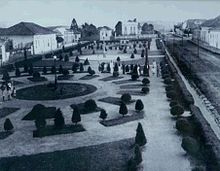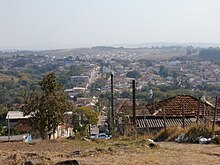Andrelândia
[13] The beginning of the colonization of European origin in the region of the current city of Andrelândia was a consequence of the gold exploitation in the south of the state of Minas Gerais.
Many people demarcated an extension of wasteland, settled there and later took care of the legalization of possession through the granting of a letter of sesmaria, which was given by the governor of the Captaincy of Minas Gerais.
[15] In 1749, the farmer André da Silveira, feeling the need for religious assistance, asked the Bishop of Mariana for permission to build a church dedicated to Our Lady of Porto in the place called Turvo Pequeno.
[16][17] After the construction of the chapel, in 1827, the Arraial do Turvo was already in conditions to be elevated to parish, which in fact occurred, having, from then on, a progressive growth, until it was transformed into a village in 1864, by law nº 1.191 of July 27 of this year.
The closest indigenous tribe was found farther south in Minas Gerais, in the region surrounding the springs of the Verde and Baependi rivers, near the Papagaio Mountain, around 1700.
With the low value of production and the high price of seeds and inputs, a natural consequence of a government policy that was not interested in the small producer, the man from the countryside was forced to abandon his work and look for the big urban centers, where he hoped to find some kind of work to maintain himself, or end up increasing the rate of unemployed, underemployed, slum dwellers, hungry, and even criminals.
Andrelândia is 299 kilometers away from Belo Horizonte, in an axis almost equidistant from São Joao Del-Rei, Barbacena, Juiz de Fora and Caxambu, which allows it to be located, for tourism references, in a delta between the Vertentes Region, Zona da Mata-Sul (English: Forest South Zone) and Circuito das Águas (English: Water Circuit).
The Aiuruoca River flows into the Rio Grande, outside the lands of Andrelândia, into the large artificial lake of the Camargos Hydroelectric Power Plant.
Species of wolves, foxes, field dogs, ocelots, wild cats, deer, coatis, paca, capybara and marmosets can still be found, although in much reduced numbers, thanks to the invasion of their habitat by man.
Of the birds that inhabit the region, the largest are the seriema, the vulture, the hawk, the wild duck, the teal, the paturi, the white heron and the stork.
André da Silveira felt the need to build a chapel where people could gather, together with their families, to participate in the liturgical acts of the Catholic faith.
Although in recent years the growth of other religious beliefs has been noticed, the municipality still has an eminently Catholic social matrix and 89% of the population shares this faith.
The bishop of the Roman Catholic Diocese of São João del-Rei, José Eudes Campos do Nascimento, gave start to the process of recognition of santity of Ward in 2020.
However, the Brazilian legal system follows the Roman-Germanic tradition of positive law,[61] where municipal administration takes place through the executive and legislative branches.
Such a struggle, however, lost its meaning long ago due to the city's lack of great resources, as the division of its community leads it to stagnation and retrogression.
When it was founded it was composed of five districts: Turvo (Headquarters), Arantes, Bom Jardim, Madre de Deus do Rio Grande and São Vicente Ferrer.
[8] Some of the poorest neighborhoods are Santos Dumont and Vila Zamoura, where the city government needed to build houses for victims of a heavy rainfall at the end of 2008.
Currently the city's commerce still attracts consumers from neighboring towns for purchases of basic necessities, furniture and household appliances, with only the absence of car dealerships and other highly complex services.
[7] In Andrelândia, as in most of the old cities of the state, the castor oil lamp was used for the internal lighting of the residences and, in the streets, it was used only on festive days, when all the windows were illuminated.
Later it was replaced by the Minas Gerais Energy Company (Cemig) which, even today, as in practically the whole state, is responsible for the city's electricity supply service.
During the administration of Gabriel Ribeiro Salgado (1923-1926), the construction of the first road for automobiles in Andrelândia began, connecting the city to São João del-Rei.
[103] Visconde de Arantes provided Andrelândia with the passage of the West of Minas Railroad, which linked São João del-Rei to the Sítio station, currently the city of Antônio Carlos.
Until August 1996, the Trem Mineiro of the old RFFSA, operated its trips on weekends, always presenting a great demand of passengers in the connection with Ribeirão Vermelho and Barra Mansa, causing an intense movement of them in the railway station of Andrelândia.
[108] The Trade Path is a very important variant of the Royal Road and along it there is a huge and varied number of cultural and scenic attractions, besides several places for the practice of the so-called ecotourism: The beautiful waterfalls and trout breeding ponds in the region between Rio Preto and Bom Jardim de Minas; the colonial architecture, the archaeological sites, the typical sweets and cheese and the quality cachaça produced in the region of Andrelândia; the century-old farms and churches, the mountain ranges and the folkloric traditions of the Madre de Deus de Minas region.
A serious problem is the decharacterization of many colonial houses due to the substitution of the primitive roof tiles by modern French tiles, forming a mixture of styles that has already occurred in the residences that belonged to Major Gustavo Ernesto Alves, to the Viscount of Arantes, and even with the oldest specimen of the city's colonial residential architecture, today represented by a simple remnant, with its worn stone sills denouncing the antiquity of its existence.
In various parts of the city, it is possible to find a differentiated handicraft production, made with regional raw materials and created according to the local culture and way of life.
[119] In Andrelândia, throughout the years, several bands based in the city have stood out regionally, with emphasis on the classical style groups, such as the 15 de Agosto, Santa Cecília, the Musical Corporation "Irmãos Leite", besides the Andrelandense Musical Society Saint Pius X, today known as Saint Pius X Band, founded by maestro Rufino on March 4, 1955, and exists until today, being conducted by maestro Wilson Pereira.
The most traditional blocks in the municipality are: Nem Ligo do Areão, Unidos do São Dimas, Confetes ao Vento, and Das Virgens.
[120][10] Established by Municipal Law 1 311/2002, the Commandery honors annually, on July 20, the anniversary of the city's foundation, up to ten citizens in the political, business, social, and cultural fields, who have rendered exceptional services to the local community.
The municipal holidays are: Corpus Christi, always held on the Thursday following Holy Trinity Sunday,[125] the anniversary of the emancipation of Andrelândia on July 20,[126] and the Assumption of Our Lady on August 15.













